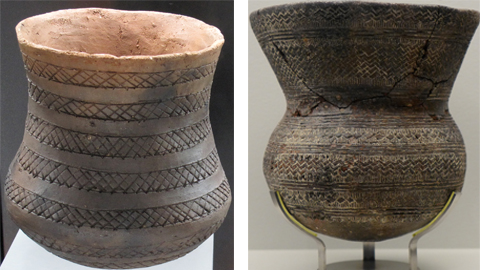Ancient DNA reveals impact of the “Beaker Phenomenon” on prehistoric Europeans

22/02/2018
Between 4,750 and 4,500 years ago, a new bell-shaped and highly decorated pottery style known as the Beaker pottery spread across western and central Europe in one of the defining periods in European prehistory. For over a century, archaeologists have tried to establish whether the spread of “Beaker” pottery represented a large-scale migration of people, was simply due to the spread of new ideas, or was a combination of both.
Now, the largest study of ancient DNA ever conducted and made up of an international team of 144 scientists reveals the complex story. The analysis of 400 prehistoric skeletons (from the Neolithic, Copper Age and Bronze Age) stemming from different European sites, among which were 11 sites from the Iberian Peninsula, reveals that different situations occurred all across Europe. The study, published in Nature, included the participation of Roberto Risch and Ignacio Soriano, researchers at the Department of Prehistory at the Universitat Autònoma de Barcelona (UAB).
The expansion of the beaker phenomenon from the Iberian Peninsula – where, according to the available 14C dates, the oldest samples of this pottery style were found - towards Central Europe was not due to a significant movement of people. Iñigo Olalde, geneticist at Harvard Medical School in Boston, USA, and first author of the study says that “DNA from skeletons associated with Beaker burials in Iberia was not close to that in central European skeletons”.
“This is the first clear example from ancient DNA that pots do not always go hand-in-hand with people” says geneticist David Reich, who works with Olalde and is also researcher at the Howard Hughes Medical Institute and at the Broad Institute of MIT and Harvard. “The large sample sizes make it possible to paint subtler pictures of ancient human variation than we could before.”
Genetic Isolation between the Iberian Peninsula and Central Europe
In the specific case of the Iberian Peninsula, scientists observed that there is a direct genetic continuity among the Neolithic populations prior and posterior to the Copper Age and Beaker culture. “It is very interesting to observe how Iberia on one side and central Europe on the other maintained markedly isolated genetics at the end of the Neolithic, some 5,000 years ago, despite numerous archaeological evidences of interactions and contacts between both regions”, highlights Roberto Risch, Professor of the Department of Prehistory at the Universitat Autònoma de Barcelona. “The study clearly shows that the introduction of Bell-Beaker pottery into central Europe some 4,500 years ago was in no way related to the arrival of people from the Iberian Peninsula, which was long defended as being true. The rapid adoption of this pottery style, which had to go together with very specific consumption practices, rather expressed the development of new forms of communication between the south-west and centre of Europe”.
Surprisingly, Beaker pottery was adopted in central Europe by groups of people arriving from the east. “In 2015 we conducted another international study in which we demonstrated that around 4,500 years ago there was a minimum 70% replacement of the population of north-central Europe by massive migrations of groups from the eastern European steppe. This new study reveals how the wave rolled west," says co-senior author Wolfgang Haak from the Max Planck Institute for the Science of Human History in Germany.
“However, in this expansion towards the west the Beaker pottery is no longer an expression of collective practices of consumptions, as seen in the Iberian Peninsula, but rather incorporated into individual tombs, in which the men commonly appeared with distinctive and distinguished weapons, such as copper daggers, bows and arrows”, Risch specifies.
The pattern is clearest in Britain, where the new study reports 155 samples ranging in age from between about 6,000 and 3,000 years ago. According to geneticist Ian Barnes from the at London’s Natural History Museum, “the skeletal remains of individuals from Britain who lived shortly after this time have a very different DNA profile to those who came before. At least 90% of the ancestry of Britons was replaced by a group from the continent. Following the Beaker spread, there was a population in Britain that for the first time had ancestry and skin and eye pigmentation similar to the majority of Britons today.”
“Curiously, some 4500 years ago, the Iberian Peninsula began gradually to introduce individual funeral rites with grave goods which ennobled the individuals through the association with metal weapons and bell-beaker pottery. But here, contrary to what happened in the British Isles, there is no clear genetic change”, says UAB Professor Ignacio Soriano. “This time the changes came from the north and caused such an important social rupture that the consequences were seen in the Bronze Age, some 4,200 years ago”.
“In relation to peninsular prehistory, it is made obvious that the genetic composition of the first communities manufacturing metal weapons was quite different from the current societies living in the Iberian Peninsula. Our next challenge is to determine how and when these migrations took place and gave way to the introduction of the 'steppe' component in the Peninsula which is visible today”, Risch adds.
The successful analysis of so many samples was possible thanks to two recently introduced methods that greatly reduce the cost per sample of ancient DNA analysis. One involves a chemical treatment that allows the researchers to focus their sequencing on the tiny part of the genome that is most useful for analysis. Another major contributor is the realization that DNA yields from petrous bones are much higher than in any other parts of the skeleton.
Original article: “The Beaker phenomenon and the genomic transformation of northwest Europe.” doi:10.1038/nature25738